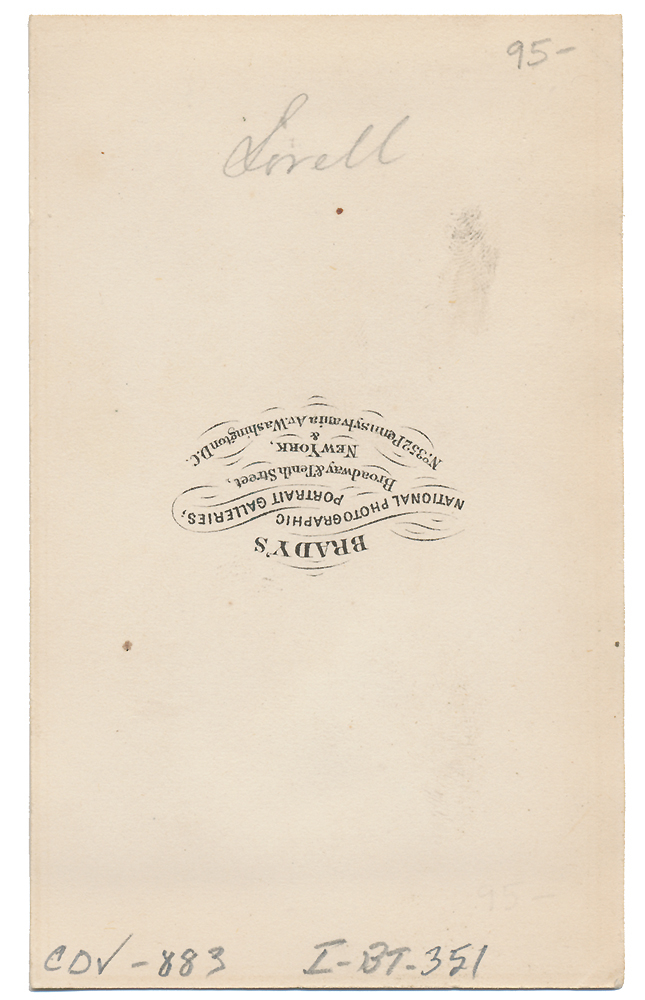site search
online catalog
SEATED VIEW OF CONFEDERATE GENERAL MANSFIELD LOVELL

Hover to zoom


$450.00
Quantity Available: 1
Item Code: 1138-351
Shipping: Determined by Method & Location of buyer
To Order:
Call 717-334-0347,
Fax 717-334-5016, or E-mail
Very nice view of Lovell seated in the uniform of a Confederate general. He wears a double-breasted frockcoat with very clear collar insignia and galloons on the sleeves. He wears dark trousers and about his wait is his sash and sword belt. Belt has a circular plate very reminiscent of the US Pattern 1826 eagle breast plate. Bottom of the mount has a bold period ink ID that reads “MAJ. GEN. MANSFIELD LOVALL, C.S.A.”
Clarity and contrast are excellent. Mount and paper are very clean.
Reverse has a photographer’s imprint for BRADY’S GALLERY… Reverse also has “LOVELL” in period pencil as well as some collector information also in pencil.
From the collection of the late William A. Turner.
Mansfield Lovell was born October 20, 1822 in the District of Columbia. His father was Joseph Lovell, the eighth Surgeon General of the United States Army.
Mansfield Lovell graduated from the United States Military Academy in 1842 and was commissioned as a second lieutenant in the U.S. artillery. He was severely wounded during the Battle of Chapultepec in the Mexican War, receiving a brevet appointment to captain for his service. He resigned from the army in 1854 to join the abortive Cuban expedition of General John A. Quitman. He then moved to New York City, where he engaged in business and served as deputy street commissioner.
With the outbreak of the Civil War, Lovell left New York City and enlisted in the Confederate army. He was appointed as a major general on October 7, 1861, to replace Maj. Gen. David Twiggs in command at New Orleans.
Lovell concentrated on plans to repel Union land forces from approaching the city from the Upper Mississippi area. Forts Jackson and St. Philip, the two Confederate forts at the mouth of the river, were believed sufficient to discourage an up-river assault. Due to commitments elsewhere the Confederate forces defending the city were small. Union forces landed on the Louisiana coast in February 1862, while their ships attacked the forts defending the city. When the forts could not be captured after several days' bombardment, the Union fleet slipped past them under cover of darkness and within four days appeared at the city's docks. The decision was made to evacuate the land defenses from New Orleans for use in fighting in the Louisiana interior and other parts of the Confederacy. It is believed Lovell's preparations to protect the city from a land invasion were sound, but the Union fleet’s threat to bombard the vulnerable city brought an end to Confederate New Orleans.
After the fall of New Orleans Lovell commanded an infantry division under Maj. Gen. Earl Van Dorn at the Second Battle of Corinth. He was later relieved of command as a consequence of his poor performance at New Orleans. Stung by this reprimand, he demanded a court of inquiry, which met in April 1863 and declared him innocent of charges of incompetence. However, he was not given any assignments for the rest of the war.
Lovell farmed a rice plantation near Savannah, Georgia, immediately after the war, but a tidal wave destroyed his first crop, forcing him to return with his family to New York City. He resumed his career as a civil engineer and surveyor. Lovell worked under the supervision of former Union general John Newton on a project to clear obstructions from the East River at Hell Gate. He died in New York City and was buried in Woodlawn Cemetery in The Bronx. [ad] [ph:L]
~~~~~~~~~~~~~~~~~~~~~~~~~~~~~~~~~~~
THIS ITEM, AS WITH ALL OTHER ITEMS AVAILABLE ON OUR WEB SITE,
MAY BE PURCHASED THROUGH OUR LAYAWAY PROGRAM.
CLICK HERE FOR OUR POLICIES AND TERMS.
THANK YOU!
Inquire About SEATED VIEW OF CONFEDERATE GENERAL MANSFIELD LOVELL
Most Popular
Historical Firearms Stolen From The National Civil War Museum In Harrisburg, Pa »
Theft From Gravesite Of Gen. John Reynolds »
Selection Of Unframed Prints By Don Troiani »
Fine Condition Brass Infantry Bugle Insignia »
Large English Bowie Knife With Sheath 1870’S – 1880’S »
Imported (Clauberg) Us Model 1860 Light Cavalry Officer's Saber »
featured item
UNION CAVALRY GENERAL WILLIAM WELLS’ FIELD BLOUSE: MEDAL OF HONOR FOR GETTYSBURG WHERE HE RODE IN THE LEAD OF FARNSWORTH’S CHARGE; BRIGADE COMMANDER UNDER CUSTER; BLOUSE ACTUALLY WORN IN ONE OF HIS PHOTOS
This coat is the epitome of a Civil War Union general’s field uniform, a blouse following the popular sack coat pattern of the period, looking somewhat like an enlisted man’s fatigue blouse and suitable for campaign wear, but with a double row of… (1179-281). Learn More »


